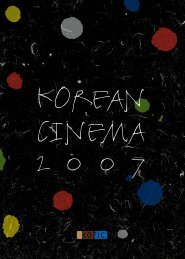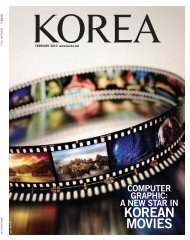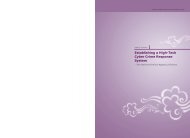My Impression of Korea - Korea.net
My Impression of Korea - Korea.net
My Impression of Korea - Korea.net
- No tags were found...
You also want an ePaper? Increase the reach of your titles
YUMPU automatically turns print PDFs into web optimized ePapers that Google loves.
BOOKS<br />
(From left)<br />
<strong>Korea</strong>n-English,<br />
Vietnamese and<br />
Mongolian versions<br />
<strong>of</strong> Hunminjeongeum<br />
Jiphyeonjeon, meaning the<br />
hall <strong>of</strong> worthies in <strong>Korea</strong>n, is<br />
where Joseon scholars<br />
created and studied Hangeul<br />
(top) and the ceremony to<br />
declare the creation <strong>of</strong><br />
Hangeul<br />
Hunminjeongeum<br />
Translated into<br />
Four Languages<br />
Author: The National Institute <strong>of</strong> <strong>Korea</strong>n Language<br />
Publisher: Thinking Tree<br />
Pages: 160<br />
The National Institute <strong>of</strong> <strong>Korea</strong>n Language<br />
has launched the <strong>Korea</strong>n document “Hunminjeongeum”<br />
in four languages: English,<br />
Chinese, Mongolian and Vietnamese.<br />
Huminjeongeum, meaning “correct sounds<br />
to instruct the people,” is <strong>Korea</strong>’s first instruction<br />
book on Hangeul, <strong>Korea</strong>n unique writing<br />
system, published in 1446 by King Sejong the<br />
Great (1397-1450) who also created the characters.<br />
<strong>Korea</strong> celebrated its 562nd anniversary<br />
<strong>of</strong> the creation <strong>of</strong> Hangeul on Oct. 9.<br />
As the original copy <strong>of</strong> the book is written<br />
in classical Chinese characters with Hangeul<br />
additions, it has been even harder for foreigners<br />
to approach. The latest editions include<br />
extra explanation that details the characteristics<br />
<strong>of</strong> the book and its value from the per-<br />
The portrait <strong>of</strong> King Sejong the Great<br />
spective <strong>of</strong> linguistic study. Attached to the<br />
original text is a modern <strong>Korea</strong>n translation in<br />
Hangeul.<br />
The book also includes the “Haeryebon”<br />
version (explanation and examples <strong>of</strong> correct<br />
sounds to teach people), that details how<br />
each Hangeul character is supposed to be<br />
pronounced.<br />
Pr<strong>of</strong>essor Kim Joo-won and Lee Sang-eok<br />
<strong>of</strong> Seoul National University were put in<br />
charge <strong>of</strong> writing the explanation for<br />
Hunmingjeongeum. The Hangeul translation<br />
<strong>of</strong> the original was done by honorary pr<strong>of</strong>essor<br />
Shin Sang <strong>of</strong> Chonnam National<br />
University.<br />
“Aside from English we have also published<br />
it in Chinese, Mongolian and<br />
Vietnamese versions as these countries show<br />
a big interest in <strong>Korea</strong>n culture and demands<br />
are higher than in other areas,” one <strong>of</strong>ficial<br />
from the institute explained. “In the long run<br />
we plan to publish books in French, German,<br />
Russian, Spanish and other languages to<br />
promote the book that marked the birth <strong>of</strong><br />
<strong>Korea</strong>’s very own writing system.”<br />
The English version will be distributed to<br />
<strong>Korea</strong>n cultural centers worldwide and <strong>of</strong>fered<br />
to overseas scholars in related fields. It<br />
is also currently on display at local bookstores.<br />
■<br />
62 KOREA NOVEMBER 2008<br />
NOVEMBER 2008 KOREA 63
















